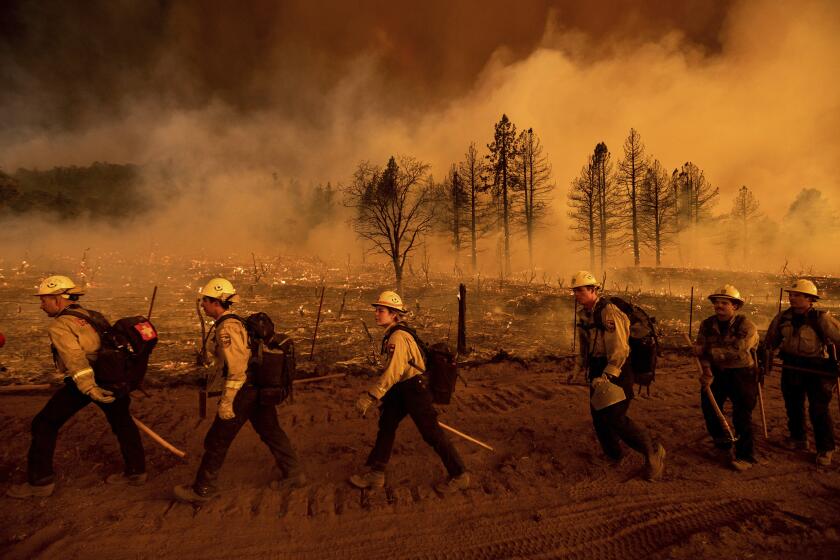Brunt of atmospheric river storm hits L.A. today: Timing, trouble spots, evacuations and more

- Share via
The most powerful phase of Southern California’s strongest atmospheric river storm of the winter is arriving Thursday, and it’s expected to bring significant flooding to roads and a high risk of landslides.
The rains Thursday are expected to peak — and depart — a little earlier than previously forecast, the National Weather Service in Oxnard said.
There’s a “high risk of flooding, debris flow, damaging winds,” the weather service said. “Change travel plans and avoid roads on Thursday. Conditions could escalate quickly with little warning.” The weather service also suggested parking away from trees and charging up electronics.
Here’s what you need to know about timing, evacuation orders and warnings, areas at greatest risk and more:
Timing
Here’s when certain counties are expected to see the brunt of the storm; the timing could vary by as much as a few hours earlier or later:
San Luis Obispo County: 8 a.m. to 4 p.m.
Santa Barbara County: 10 a.m. to 6 p.m.
Ventura County: 12 p.m. to 8 p.m.
Los Angeles County: 2 p.m. to 10 p.m.
Orange County and Inland Empire: 5 p.m. to 10 p.m.
San Diego County: 8 p.m. to 2 a.m.

Evacuations
Evacuation warnings were issued in a number of burned areas. Evacuation maps may be found here and here.
Los Angeles County:
Pacific Palisades: The area will be limited to residents only from 7 a.m. Thursday to 2 p.m. Friday. Contractors with passes will not be allowed entry. Evacuation warnings were issued for the Getty Villa area, a portion of the Highlands neighborhood near the burned area, the northern section of the Bienveneda Avenue area, a northern section of Temescal Canyon Road, the northern edge of Marinette Road and Oracle Place, and the area around Will Rogers State Park Road, including Villa Woods Drive and Villa Grove Drive.
Brentwood: A warning was issued for Mandeville Canyon Road north of Tanners Road.
Malibu: An evacuation warning was in place for roughly the eastern half of Malibu, from the eastern edge of the city to the intersection of Pacific Coast Highway and Malibu Road, near Bayshore Drive. The warning area includes the Malibu Civic Center and Pepperdine University. Pepperdine is shifting to remote classes on Thursday. The university said that consulting engineers said the Malibu campus had a “low risk of challenges from debris flow” and said an evacuation order for Pepperdine would be “highly unlikely.” Malibu’s public schools will be closed Thursday.
Sunset Mesa: The unincorporated area, sandwiched between Malibu and Pacific Palisades just north of Pacific Coast Highway, is under an evacuation warning.
Hollywood and Hollywood Hills West: Warnings are also in effect around the Sunset fire burn zone around Runyon Canyon, including the northernmost blocks of North Vista Street and North Curson Avenue.
Sylmar: Evacuation warnings were in effect for a few homes on the western edge of Oakridge Mobile Home Park.
Calabasas: Warnings were in effect in the Malibu Canyon and Alizia Canyon neighborhoods.
Altadena: Warnings were issued for northern areas of Altadena adjacent to the San Gabriel Mountains.
Kinneloa Mesa: The neighborhood is under an evacuation warning.
Pasadena: A northeastern neighborhood is under a warning, including the northern few blocks of Hastings Ranch Road and Park Vista Drive.
Sierra Madre: Northern areas of Sierra Madre are under an evacuation warning.
San Gabriel Mountains: Areas between East Fork Road and Shoemaker Canyon Road along the San Gabriel River are under a warning.
Orange County
Officials in Orange County issued a voluntary evacuation warning for the Trabuco Canyon, Hot Springs Canyon, Bell Canyon, Long Canyon and Modjeska Canyon areas because of the risk of debris flows near the Airport fire burn scar. The evacuation warning will take effect beginning at 8 a.m. Thursday.
San Bernardino County
Evacuation warnings were issued for the unincorporated communities of Mount Baldy Village and Wrightwood, as well as some northern and eastern neighborhoods of the city of Highland.
Santa Barbara County
The county issued an evacuation order for portions of the area in and around the burn zone of the Lake fire in the mountains north of Los Olivos. An evacuation warning was in effect for a wider area.
Burn scars at highest risk
Areas recently burned by wildfire are at risk of seeing landslides, such as debris flows.
That type of landslide can move as fast as 35 mph, and is capable of destroying homes and threatening lives.
All recently burned areas are of concern, but these three are of most concern, according to the weather service office in Oxnard:

• Palisades (23,707 acres) and Franklin (4,037 acres) burn scars in Pacific Palisades and Malibu.
• Eaton (14,021 acres) burn scar in Altadena.
• Bridge (56,030 acres) burn scar in the San Gabriel Mountains, west and southwest of Wrightwood.
Mount Baldy Village, adjacent to the Bridge burn scar, sits below an area that is susceptible to heavy rain, and could see significant land movement if heavy rain occurs, said Alex Tardy, a meteorologist with the weather service office in San Diego.

Here are other burn scars that forecasters are watching closely:
• Line (43,978 acres) burn scar in San Bernardino County, from Highland to near Big Bear.
• Lake (38,664 acres) burn scar in the mountains of Santa Barbara County, north of Los Olivos.
• Airport (23,526 acres) burn scar in the Santa Ana Mountains.
• Mountain (19,904 acres) burn scar south of Santa Paula and north of Camarillo.
• Hughes (10,425 acres) burn scar around Lake Castaic.
• Kenneth (1,052 acres) burn scar west of Woodland Hills and north of Calabasas.
• Hurst (799 acres) burn scar in the Sylmar area.
• Sunset (43 acres) burn scar in the Hollywood Hills West neighborhood.
• Post (15,563 acres) burn scar south of Gorman, near the Grapevine section of Interstate 5.
• Apache (1,538 acres) burn scar in rural northwestern Ventura County.
• Lidia (395 acres) burn scar on the northern slopes of the San Gabriel Mountains near Acton.
A main concern in the Airport burn scar is the potential for debris flow into Trabuco Canyon, Tardy said.

Areas that could see the heaviest rain
When rain falls at half an inch per hour or more, debris flows could be triggered in recently burned areas.
Here are the areas that may see concerning rates of rainfall during the peak of the storm. Note that rates could vary by more than a quarter of an inch per hour faster or slower than those listed below.
But they offer “a pretty good idea as far as what you could expect during the peak period of this storm,” said Ryan Kittell, meteorologist with the weather service office in Oxnard.
Lake burn scar: 0.76 of an inch of rain per hour.
Eaton burn scar: 0.72 of an inch per hour.
Bridge burn scar: 0.65 of an inch per hour.
Palisades and Franklin burn scars: 0.6 of an inch per hour.
Hurst burn scar: 0.6 of an inch per hour.
Mountain burn scar: 0.54 of an inch per hour.
These rates are not expected all day. For most of the peak time of the storm in each county, rain is forecast to fall at more modest rates of a quarter of an inch to half an inch per hour, Kittell said.
But it’s the brief bursts of heavy rain that could pose the most problems. And there are a few projections that show rainfall rates of more than an inch per hour.
“We really could see those anywhere,” Kittell said. “It just won’t be necessarily widespread. It just depends on where those heavier [storm] cells ... materialize.”
Factors that can contribute to debris flows
Brief bursts of heavy rain can trigger debris flows, a type of potentially dangerous shallow landslide.
Debris flows occur when water rapidly flows downhill and picks up not only mud but also rocks, branches, sometimes even massive boulders and cars.

They can damage or destroy homes, and threaten lives. Months after the 160,557-acre Station fire of 2009, the largest wildfire in L.A. County history, a major debris flow on Feb. 6, 2010, inundated more than 40 homes in La Cañada Flintridge’s northernmost neighborhood with mud, boulders and dented cars.

Animated infographic shows a debris flow works
The culprit was an intense band of rain cells that formed over the burned mountains and a 10-ton boulder that had plugged up the Mullally Canyon debris basin, which was designed to catch ashen mud as it poured from the slopes. Officials later built a $1.5-million drain pipe to divert rainwater away from the basin and worked to increase storage capacity of the area’s catch basins.

Other potential impacts from this storm
Other expected impacts from this storm include:
• Damaging winds. Gusts could hit 40 to 65 mph in the mountains, deserts and Central Coast, and 20 to 40 mph elsewhere.
• Downed trees and power outages.
• Delays at airports.
• Dangerous seas and harbors.
• A likelihood of swift-water rescues in rivers.
More to Read
Sign up for Essential California
The most important California stories and recommendations in your inbox every morning.
You may occasionally receive promotional content from the Los Angeles Times.













